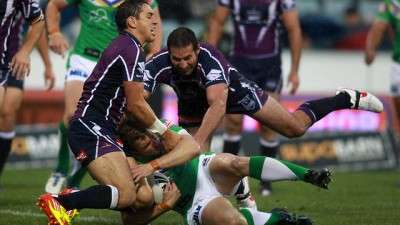NRL Melbourne Storm players take on Canberra Raiders opponent. Image: Gary Ramage / News Limited
Media representation of concussion management in rugby league could affect public understanding of appropriate medical care, according to a new study.
A study analysing television footage of the 2010 Telstra Premiership Rugby League (National Rugby League) to determine how often on-field injury resulted in probable concussion found rugby league players experienced visible signs of concussion more frequently than previously reported.
The study, led by Monash University’s Dr Audrey McKinlay and Dr Taylor McLellan from the University of Canterbury, also examined how injuries to the head were managed with respect to return-to-play procedures. It found 60 per cent of injured players continued playing following apparent mild traumatic brain injury (concussion), one of the most common injuries in contact sports.
Dr McKinlay, from the School of Psychology and Psychiatry, said apparent concussion was often managed in a way contrary to common medical advice. This could have a flow-on effect, so that non-sporting injuries were also treated inappropriately.
“Research shows that concussion-related symptoms do not resolve for around 48 hours. It appears rugby league players are playing on despite being symptomatic and the viewing audience is privy to this practice,” Dr McKinlay said.
“Part of the problem is that sports administrators, fans and even commentators tend to praise athletes who stay on the field after sustaining a head injury.
“However, early return to play could result in a slower brain recovery or exacerbate symptoms including dizziness and loss of memory or in some instances mean permanent brain damage.”
The study found the most common cause of injury in rugby league was a high tackle.
Dr McKinlay said the study would inform further investigation into how media exposure affects the viewing public’s knowledge and understanding of concussion management.
More information: Brain Injury Awareness Week is being observed from 13-19 August.
Provided by Monash University





















